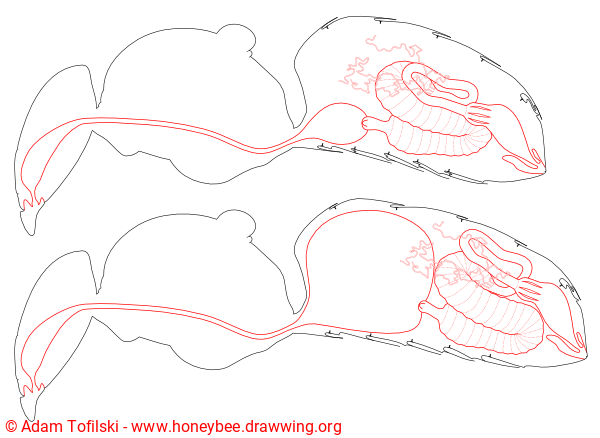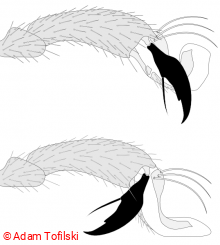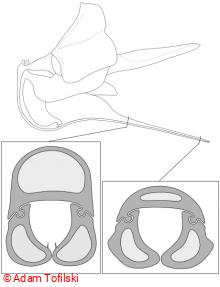
Crop of honey bee worker when empty (top) and filled with nectar (bottom). After Winston (1987, fig. 3.15) The biology of the honey bee,
, Cambridge, (1987)
[1].
The crop (also called honey stomach or honey sack) is a specialized part of foregut. It is similar to distensible sack. The main function of the crop is transport and storage of liquid food (water, nectar and honeydew). Another function of crop is uptake of water from its lumen Aquaporins in the honeybee crop—a new function for an old organ,
, p.(in press), (2014)
[2]. This is possible thanks to aquaporins - proteins which can transport water across membranes. The proteins are present in the crop epithelium Aquaporins in the honeybee crop—a new function for an old organ,
, p.(in press), (2014)
[2]. The uptake of water from crop can be important for processing of nectar (or honeydew) and production of honey. This can explain why nectar in crop contains more sugar than nectar collected from flowers Bees get a head start on honey production,
, Volume 4, Number 3, p.299–301, (2008)
[3] but see Studies on the changes in nectar concentration produced by the honeybee, Apis mellifera. Part 1. Changes which occur between the flower and the hive.,
, Volume 151, p.211-243, (1932)
[4]. In earlier studies it was suggested that inner crop walls are impermeable to water Über das „Spritzen" der Bienen und über die Konzentrationsänderung ihres Honigblaseninhalts,
, Volume 28, Number 3, p.197–210, (1940)
[5]Inversion of cane sugar in the honey stomach of the bee,
, Volume 44, Number 4, p.487–492, (1951)
[6].
The crop wall consists of three layers: epithelium and two layers of muscles Über den Nahrungstransport im Darm der Honigbiene,
, Volume 34, Number 3, p.278–298, (1952)
[7]. The innermost epithelium is covered with cuticle. It is extremely folded which allows increase of the crop volume.
The volume of the crop can increase about ten times during filling. When filled with food the crop is not distended uniformly but the dorsal side is stretching more than the ventral side Functional morphology of the honey stomach wall of the European honey bee (Hymenoptera: Apidae),
, Volume 103, Number 6, p.979–987, (2010)
[8].
Inside honey bee crop there are present lactic bacteria Detection and identification of a novel lactic acid bacterial flora within the honey stomach of the honeybee Apis mellifera,
, Volume 57, Number 4, p.356–363, (2008)
[9].
- Log in to post comments
»
- Log in to post comments





